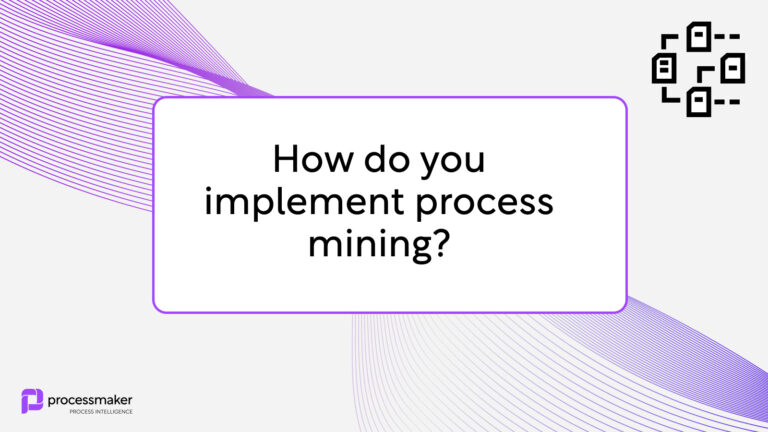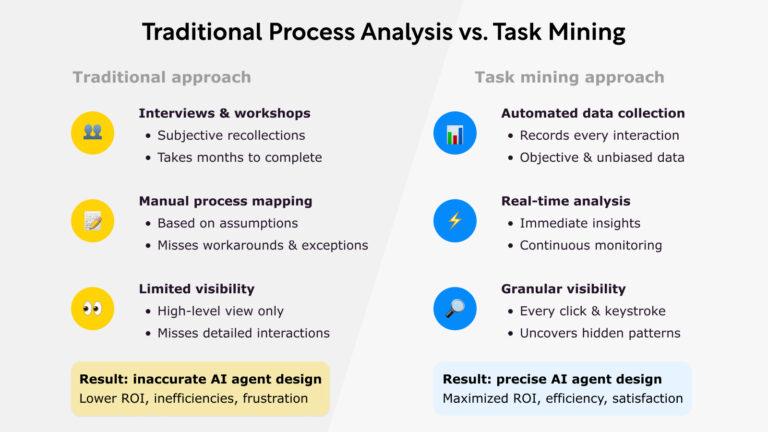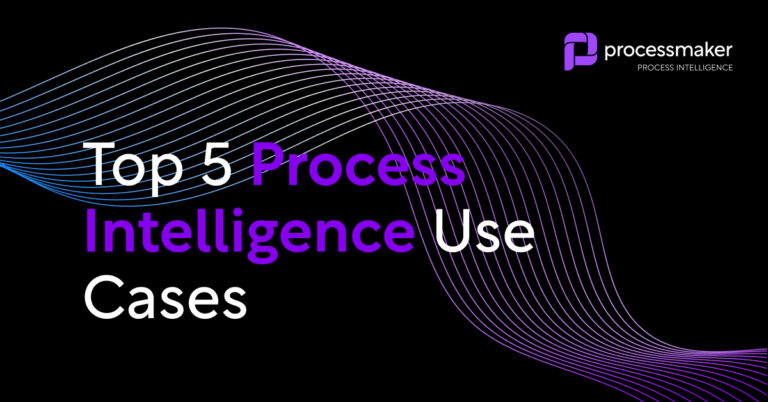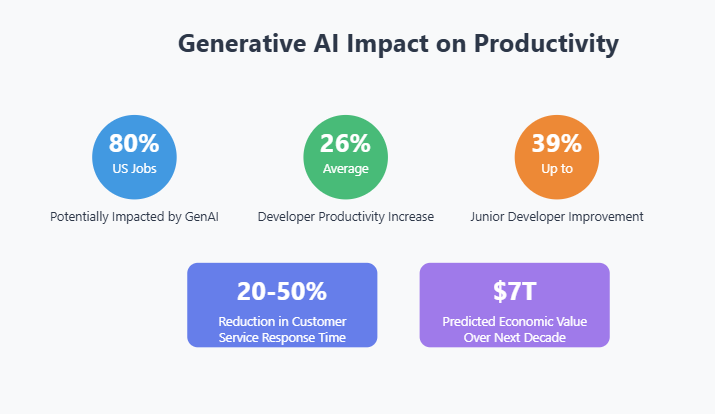Data is the lifeblood of modern businesses, fueling innovation and transformation across industries. Companies everywhere are waking up to the power of data-driven insights, and process mining is front and center.
Process mining provides a detailed, data-driven view of core business processes, enabling organizations to dive deep into the performance, productivity, and efficiency of your operations. Process mining is not a new technology. It has evolved over decades of development and innovation.
According to Deloitte, 2 in 3 enterprise businesses are using or plan to use process mining within their business operations.1
Understanding process mining
Process mining is a powerful technique used to analyze and improve business processes by extracting valuable insights from event logs. As a crucial aspect of business process management (BPM), it applies data science principles to scrutinize company processes, helping to identify patterns and trends. This technique reveals how a business actually operates, providing a clear picture of the real-world execution of processes.
Importance in business process management
In the realm of business process management, process mining is indispensable. It bridges the gap between real-time events and operational business processes, allowing organizations to streamline and enhance their workflows. By quickly uncovering valuable insights, process mining helps improve productivity and efficiency. It can be used to examine three major types of key performance indicators (KPIs): process, quality, and time, providing a comprehensive view of business performance.
Why implement process mining software?
Process mining software is a technology that utilizes advanced algorithms to analyze logs and other data from various information systems to identify trends and patterns. Selecting an appropriate process mining solution is crucial for effectively analyzing and optimizing business processes. By doing so, it provides a real-time view of business processes, highlighting bottlenecks, inefficiencies, and opportunities for improvement. 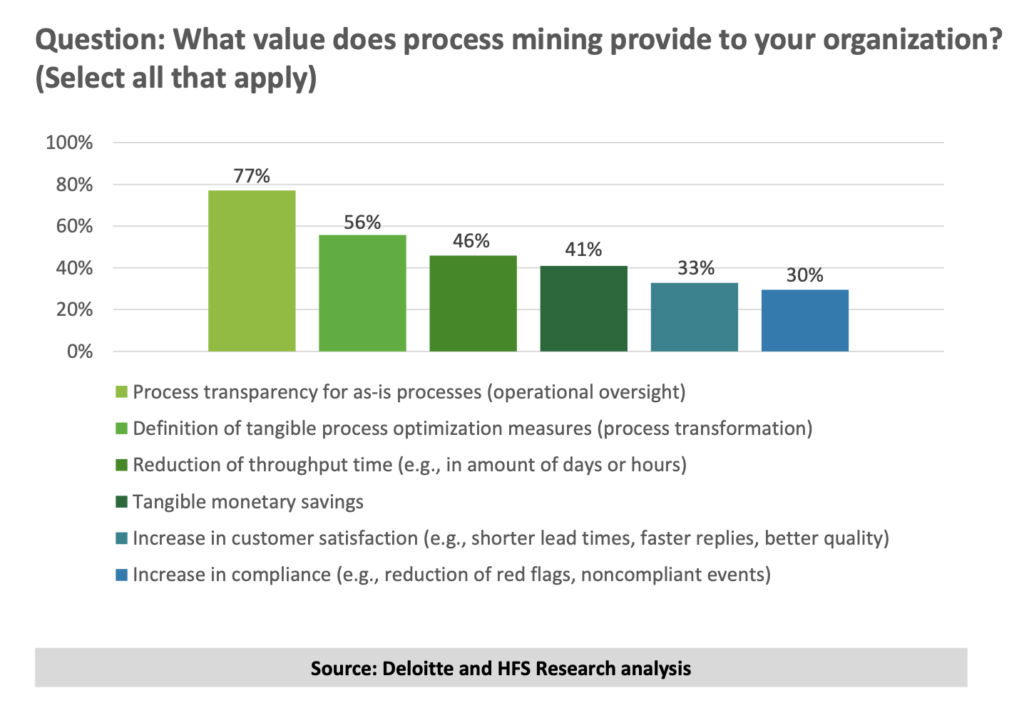
In a recent study, HFS Research and Deloitte identified various value drivers for process mining. 2
Steps to implement process mining software
Implementing process mining software is not a one-size-fits-all approach. It varies from organization to organization, depending on various factors such as size, complexity, and existing systems. However, we can identify a common set of steps that are often involved in this process.
1. Identify the process(es) to be analyzed
The first step in implementing process mining software is to identify the processes that you wish to analyze. These could be procurement, manufacturing, customer service, or any other business process. It’s essential to have a clear understanding of your business processes and where you think improvements can be made.
2. Collect or integrate event data
Once you have identified the processes, the next step is data collection. The software will need access to event logs from the systems related to the processes being analyzed. These could be ERP systems, CRM systems, databases, and more. The quality of data directly influences the effectiveness of process mining, so ensure the data is complete and accurate. In some process mining tools data can be extracted directly from source systems, while other tools use Excel files for import/export of data.
3. Verify data quality
After your process data has been collected, you often need to verify that the data is accurate and reliable. Some preprocessing might be required to clean the data and make it suitable for analysis. This may involve removing outliers, dealing with missing values, and transforming data into a suitable format. It is a good idea to include subject matter experts in data validation exercises, to make sure that the data collected matches the real-world views of the people doing the work.
4. Analyze the data
Once the data is uploaded and verified, process mining algorithms can be run to produce visualizations and analytics. Process mining algorithms are used across different use cases to discover patterns, dependencies, and trends in the data. This will provide you with a visual representation of the process, allowing you to see where there are bottlenecks or inefficiencies.
5. Interpret the results and implement process improvement changes
Finally, it’s time to interpret the results and implement changes. Process automation plays a crucial role in this phase by ensuring that workflows are optimized before any automation is applied. This is where the real value of process mining comes into play. By understanding where inefficiencies lie, you can make informed decisions to improve these areas.
6. Monitor and adjust
The implementation of process mining software is not a one-off task. It’s a continuous process that requires monitoring and adjusting. You’ll need to continuously collect data, analyze it, and implement improvements based on the findings. This will allow you to keep up with changes in your business environment and ensure continuous improvement.
Keys to successful process mining implementation
The successful implementation of process mining in an enterprise organization can lead to remarkable improvements in efficiency, productivity, and overall business performance. However, to maximize these benefits, it’s crucial to consider a number of factors that can influence the success of this digital transformation journey.
Project scope: Before you start implementing process mining, it’s crucial to define the scope of the project. Identify which processes will be subjected to analysis and what objectives you aim to achieve through this implementation. Be realistic and strategic in defining the scope, focusing on areas where process mining can provide the most significant impact.
Data quality: The success of process mining heavily relies on the quality of data you work with. Make sure the data is complete, accurate, and relevant to the processes you’re analyzing. Also, consider if your existing IT systems can provide the necessary data in an accessible format.
IT infrastructure compatibility: Assess your current IT infrastructure’s compatibility with the chosen process mining software. The software should integrate seamlessly with your existing systems to ensure smooth data collection and transfer. Stakeholder buy-in. Implementing new software, especially one that could potentially transform operations, requires substantial stakeholder buy-in. Stakeholders, from top management to the employees who will be using the software, need to understand its benefits and be committed to its success.
Training and support: Your team needs to be proficient in using the process mining software. Invest in proper training to ensure that they can utilize the tool effectively. Also, consider the level of support the software provider offers for technical issues that might arise.
Compliance and security: Ensure the chosen software meets your organization’s compliance standards and has robust data security measures in place. Remember, process mining involves analyzing potentially sensitive business data, so it’s crucial to prevent unauthorized access or breaches.
Ongoing monitoring and improvement: Implementation doesn’t end once the software is up and running. It requires ongoing monitoring and refinement. Continually analyze the results, make necessary adjustments, and look for ways to further enhance the processes.
Scalability: Lastly, consider the scalability of the software. As your organization grows, so too will your process mining needs. Choose a solution that can accommodate this growth and evolve with your business. Implementing process mining software in an enterprise organization can be a substantial undertaking, but with careful consideration of these factors, it’s an investment that can pay significant dividends. As businesses continue to navigate the digital era, tools like process mining will become increasingly crucial in driving operational excellence.
Common challenges to process mining implementation
While implementing process mining can yield substantial benefits, organizations often encounter several common challenges. One of the primary difficulties is ensuring the quality and completeness of data, as incomplete or inaccurate data can significantly hinder the accuracy of process mining outcomes. Another common challenge is gaining full stakeholder buy-in, particularly from those who will be most affected by the changes process mining may bring.
Technical issues, such as integrating the process mining software with existing IT systems and data sources, can also be problematic. Organizations may also struggle with training staff to use new software efficiently and effectively. Lastly, compliance and security issues can present challenges, particularly in sectors with strict data regulations. Each of these challenges needs to be carefully addressed to ensure successful process mining implementation.
The Bottom Line
Implementing process mining software can be a game-changer for many organizations. It provides a level of visibility into processes that were previously impossible, enabling companies to pinpoint inefficiencies and optimize processes. By following the steps outlined above, your organization can harness the power of process mining and start reaping its benefits.
